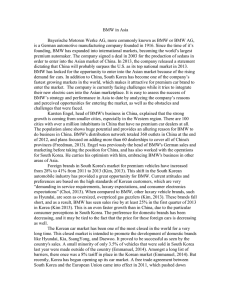The BMW Z3* In the late 1980s BMW struggled with slowing sales
advertisement
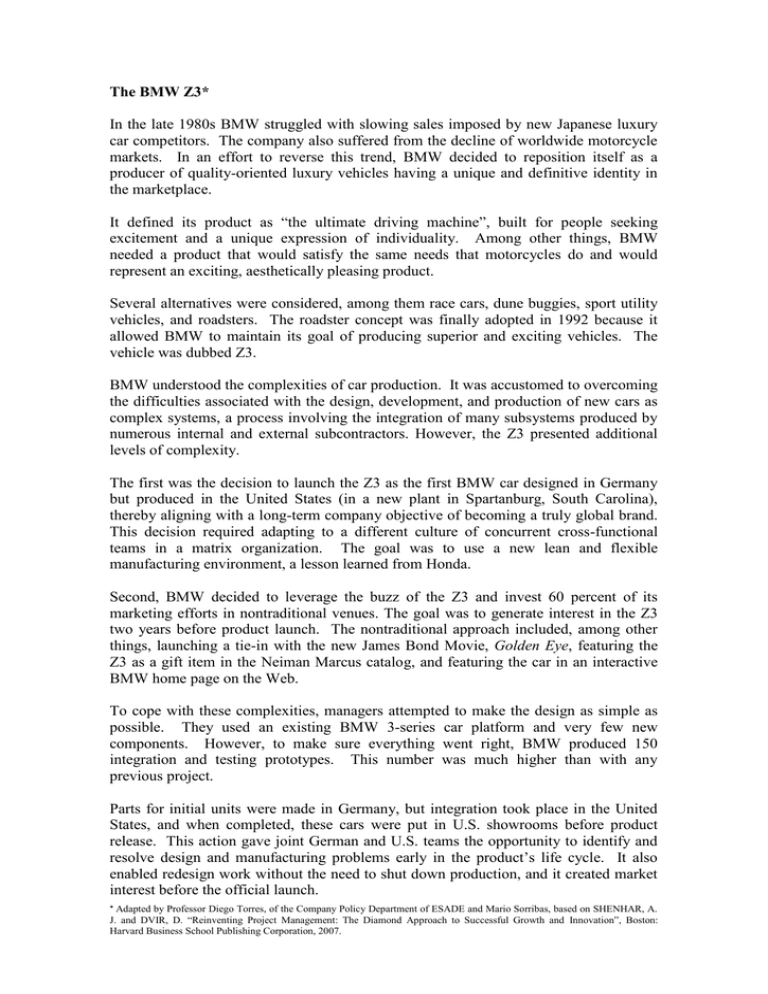
The BMW Z3* In the late 1980s BMW struggled with slowing sales imposed by new Japanese luxury car competitors. The company also suffered from the decline of worldwide motorcycle markets. In an effort to reverse this trend, BMW decided to reposition itself as a producer of quality-oriented luxury vehicles having a unique and definitive identity in the marketplace. It defined its product as “the ultimate driving machine”, built for people seeking excitement and a unique expression of individuality. Among other things, BMW needed a product that would satisfy the same needs that motorcycles do and would represent an exciting, aesthetically pleasing product. Several alternatives were considered, among them race cars, dune buggies, sport utility vehicles, and roadsters. The roadster concept was finally adopted in 1992 because it allowed BMW to maintain its goal of producing superior and exciting vehicles. The vehicle was dubbed Z3. BMW understood the complexities of car production. It was accustomed to overcoming the difficulties associated with the design, development, and production of new cars as complex systems, a process involving the integration of many subsystems produced by numerous internal and external subcontractors. However, the Z3 presented additional levels of complexity. The first was the decision to launch the Z3 as the first BMW car designed in Germany but produced in the United States (in a new plant in Spartanburg, South Carolina), thereby aligning with a long-term company objective of becoming a truly global brand. This decision required adapting to a different culture of concurrent cross-functional teams in a matrix organization. The goal was to use a new lean and flexible manufacturing environment, a lesson learned from Honda. Second, BMW decided to leverage the buzz of the Z3 and invest 60 percent of its marketing efforts in nontraditional venues. The goal was to generate interest in the Z3 two years before product launch. The nontraditional approach included, among other things, launching a tie-in with the new James Bond Movie, Golden Eye, featuring the Z3 as a gift item in the Neiman Marcus catalog, and featuring the car in an interactive BMW home page on the Web. To cope with these complexities, managers attempted to make the design as simple as possible. They used an existing BMW 3-series car platform and very few new components. However, to make sure everything went right, BMW produced 150 integration and testing prototypes. This number was much higher than with any previous project. Parts for initial units were made in Germany, but integration took place in the United States, and when completed, these cars were put in U.S. showrooms before product release. This action gave joint German and U.S. teams the opportunity to identify and resolve design and manufacturing problems early in the product’s life cycle. It also enabled redesign work without the need to shut down production, and it created market interest before the official launch. * Adapted by Professor Diego Torres, of the Company Policy Department of ESADE and Mario Sorribas, based on SHENHAR, A. J. and DVIR, D. “Reinventing Project Management: The Diamond Approach to Successful Growth and Innovation”, Boston: Harvard Business School Publishing Corporation, 2007. When all bugs had been removed, and in spite of supply delays, the Z3 captured 32 percent of the estimated target market in its first year of sales, exceeding revenue forecasts by 50 percent. Featuring the Z3 in the James Bond movie and other nontraditional marketing techniques resulted in nine thousand preproduction orders and caused a marketing paradigm shift at BMW.

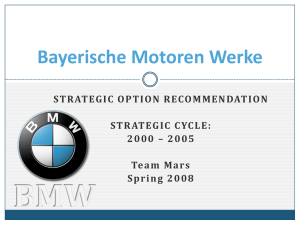
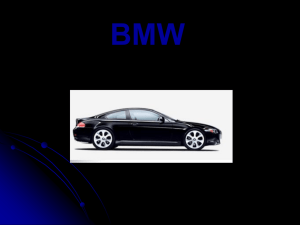
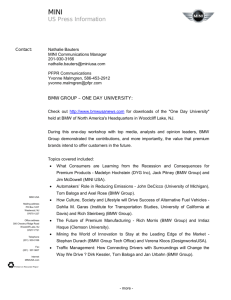
![review part 2_final [modalità compatibilità]](http://s3.studylib.net/store/data/008406144_1-f4a6579e3c064d7a6643d697d1ed922d-300x300.png)
